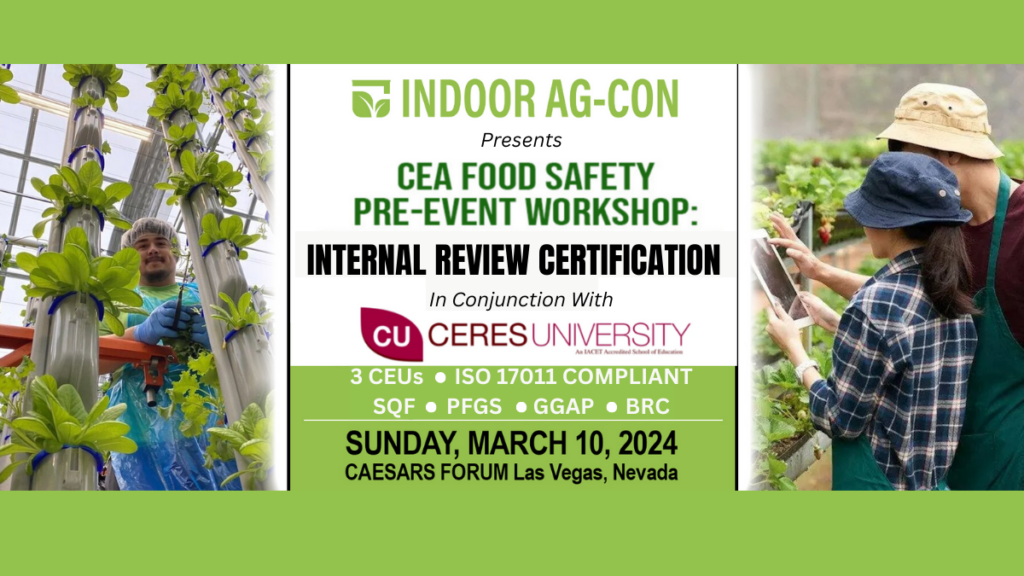
CEA Food Safety Spotlight: Pythium Is Killing CEA Profits
Indoor Ag-Con will host a CEA Food Safety Pre-Event Workshop in conjunction with Ceres University on March 10, 2024. Looking ahead to this session, we’ve launched a monthly column to explore key issues and actionable improvements you can implement for your food safety and food quality processes. This month, the experts at AME Certified PCR Laboratories explore the soil-borne fungi Pythium.
———————————————————————————————————————————————————————————————————————————
Pythium is a group of soil-borne fungi that can cause significant damage to Controlled Environment Agriculture (CEA) crops. CEA creates a controlled environment to enhance and boost plant growth. CEA produces high-quality, consistent crops year-round (FAO, 2019). Pythium can quickly turn a profitable CEA operation into a loss-making one.
Pythium fungi are known to cause root rot, damping-off, and other diseases in plants. These diseases can lead to stunted growth, reduced yield, and even plant death (Savary et al., 2019). Pythium is particularly harmful to CEA crops because the controlled environment provides an ideal environment for the fungi to thrive. The high humidity, warm temperatures, and lack of natural predators make it easy for Pythium to spread and cause damage quickly (Babiker et al., 2019).
The traditional method of detecting Pythium in CEA crops involves sending samples to a laboratory for testing. This process can be time-consuming and expensive, and by the time the results come back, the damage may have already been done. However, in-house qRt-PCR testing can rapidly, accurately, and cost-effectively solve these profit-losing issues (Gachango et al., 2016).
Quantitative, real-time polymerase chain reaction (qRT-PCR) is a molecular biology method that can detect the presence of Pythium DNA in CEA crops within one (1) hour. Managers sample plant tissue or water and qRT-PCR can provide test results that are highly accurate and reliable (Babiker et al., 2019). In addition, in-house qRT-PCR testing is much more cost-effective than sending samples to a laboratory for testing (Gachango et al., 2016).
By bringing qRT-PCR testing in-house, CEA operators can quickly detect the presence of Pythium and take applicable actions to prevent the spread of the harmful fungus, such as treating infected plants, adjusting the environmental conditions to reduce the spread of the fungus, or implementing other control measures (Savary et al., 2019).
About AME Certified PCR Laboratories
AME Certified PCR Laboratories delivers in-house testing systems to food production facilities featuring qRT-PCR(DNA), GCMS, and NGS testing systems. Learn more
 Ceres University is a leading provider of ICET-accredited food safety training and certification. With a mission to enhance food safety and quality through education, Ceres University equips professionals in the food industry with the knowledge and skills necessary to excel in their careers and ensure the highest standards of safety and quality. More information – www.ceres.university
Ceres University is a leading provider of ICET-accredited food safety training and certification. With a mission to enhance food safety and quality through education, Ceres University equips professionals in the food industry with the knowledge and skills necessary to excel in their careers and ensure the highest standards of safety and quality. More information – www.ceres.university
References:
Babiker, E. M., Mohamed, M. E., & Elshikh, M. S. (2019). Pythium species: incidence, diversity, and pathogenicity in greenhouse crops in Sudan. Journal of Plant Pathology, 101(3), 617-623.
FAO. (2019). Controlled Environment Agriculture. Food and Agriculture Organization of the United Nations. http://www.fao.org/sustainable-food-value-chains/our-work/themes/controlled-environment-agriculture/en/
Gachango, E., Wang, Y., & Wang, Z. (2016). Use of in-house qRt-PCR for quick detection of Pythium ultimum in hydroponic nutrient solutions. Journal of Plant Pathology & Microbiology, 7(1), 1-5.
Savary, S., Bregaglio, S., Willocquet, L., Gustafson, D., Mason D’Croz, D., Sparks, A., & Castilla, N. (2019). Crop health and its global impacts on the components of food security. Food Security, 11(2), 445-460.
controlled environment agriculture, lab testing, plant tissue, pythium, soil-borne fungi
